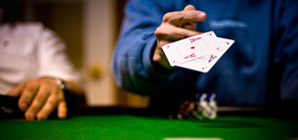One way we can simplify the concept is to think about certain bluff lines while
completely ignoring the board texture and our hole-cards. In the vast majority of games it is possible to identify good bluffing situations vs the average opponent even if all cards are dealt face-down. As such, we will not discuss any hole-cards or board textures in this two part series, we will simply consider lines.
Common Bluff Spot 1: Bet-vs-Missed-Cbet-IP
If we don't have information pertaining to how often our opponent folds after he misses his cbet in our
HUD popups we are missing out on a crucial exploitative tactic.
The facts are simple. 90%+ of opponents are capped when they miss their cbet OOP, regardless of which street they are on. We should assume vs an unknown opponent that we have significant
fold equity, enough to generate automatic profit. Our bet-vs-missed-cbet on the flop should likely be above 70% unless we are playing in very tough games.
To take a simple example – imagine SB opens and we cold-call in the BB. SB checks. There is pretty conclusive evidence to show that we can profitable fire any 2 cards. If we couldn't see our hole-cards we should fire with 100% frequency. We should only think about ditching this approach when more information regarding our opponent comes to light.
If he's taking a balanced approach where he defends
his checking range with check/calls and check/raises we'd then proceed by only betting hands with good playability on later streets and checking back a chunk of our air-range with the intention of giving up.
In other words, we should pretty much always bet vs a missed flop cbet in a HU pot when we have position. The only time we will check back is when we are slowplaying or have some type of mid-showdown value which can't extract value like 2nd pair on a safe texture. This is naturally an unbalanced strategy, but we design it this way since the average opponent has a x/f stat of over 60% when he misses his flop cbet.
Even if our opponent does manage to x/c the flop we should usually assume that his x/c range is not well constructed and that he will likely be folding to pressure on turn and river. We can include in our popups stats such as “x/f turn after skip flop cbet and x/c flop” or “x/f river after skip flop cbet and x/c flop + x/c turn”.
We should pretty much always bet vs a missed flop cbet in a HU pot when we have position. The only time we will check back is when we are slowplaying or have some type of mid-showdown value
These stats are generally under-utilised but can be brutally effective. It's likely that vs the majority of opponents we will show a clear profit by 3barreling every time they x/c the flop as the preflop-raiser.
Common Bluff Spot 2: Bet-vs-Missed-Cbet-IP-Turn+River
This strategy does not just apply to the flop. Assuming we call the flop IP and face a turn check from our opponent, we have automatic profit with a bet vs most opponents. We likely also have automatic profit with a double-barrel assuming we get called.
River can often be the most effective bluff spot if reached. Let's assume villain fires two continuation bets OOP on the flop and turn and then decides to check river. There are guys out there who have 80-100% x/f after missing river cbet OOP. Why? Very simply because if they had something strong they would fire that third-barrel for value.
There are guys out there who have 80-100% x/f after missing river cbet OOP
Probe Bets
Probe bets are

the OOP version of bet-vs-missed cbets and are almost as effective as their IP counterparts. For example imagine we cold-call in the BB vs a BTN open. We check to the PFR on the flop and he checks back. If we lead OOP on the turn this is commonly referred to as a “turn probe-bet”.
The vast majority of players are capped when they miss their cbet IP. We likely have a profitable turn probe-bet with any two cards. As such our turn probe stat should be above 70% unless we are playing in very tough games. We have to be a little more cautious seeing as we now need to evaluate whether the turn card has connected with our opponents range. We don't get to see him act before us, so we get no additional information as to whether he likes the turn card.
If the turn card is
blank which is very unlikely to connect with villain's range it can also be an excellent spot to consider incorporating an overbet-bluff range. It allows us to fold out our opponents second-pair and showdown type hands with which he may have checked the flop for pot-control.
Our turn probe stat should be above 70% unless we are playing in very tough games
The probe bet is also very effective in river situations. For example, our opponent fires a continuation-bet IP on the flop and we x/c. We check the turn and he then checks back. In most cases if he had a super strong holding he would be continuing to fire on the turn for value. His river range is likely capped (unless river card connects with his range), and we have a profitable bet or overbet.
Assuming we have our opponents' fold-to-river-probe stat on our HUD, it's often surprising how high this number can be, especially if we are routinely overbetting. As such our river probe bet should often be above 70%.
Common Bluff Spot 3: Delayed Cbetting
Pretty much any situation where our opponent decides to check twice OOP will indicate that he has a capped range.
For example if we skip our flop cbet IP and our opponent does not lead the turn we should be able to profitably fire a delayed cbet with any two cards.
As a result our delayed cbet stat should be above 70% if we are exploiting our opponents.
Identifying Capped Ranges
The key to

the exercise is identifying whether our opponent is capped. This involves numerous other situations other than just the ones described.
For example, imagine we are the PFR and we cbet the flop IP. Our opponent calls. We don't like the turn card and decide not to double barrel. Once we reach the river it's very common for our opponent to lead two types of holdings:
- Air hands such as busted draws. After all it's the only way for these hands to win the pot, not to mention we showed weakness with our flop check.
- Value-hands. We checked back the turn so our opponent will likely not assume that a river bet from us is likely. If he wants to extract value he needs to bet himself.
Which hands does this leave in our opponents range? Very specifically mid-showdown value-hands which are not strong enough to lead for value but are too strong to bluff with. This is an excellent spot to overbet. Assuming we bet a regular sizing we may end up getting looked-up by our opponents range. Assuming we overbet we may literally fold out everything.
It's important to make a differentiation between capped ranges that:
- Have a bunch of air in them but also some mid-strength showdown
- Have purely mid-strength showdown and rarely any air
A regular sized bet would likely be profitable against the first type of range whereas an overbet may be vastly superior vs the second type of range.


